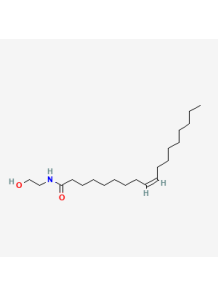N-Oleoylethanolamine (OEA, Oleamide MEA)
bioactive lipid mediator with several potential health benefits, particularly related to obesity, inflammation, and oxidative stress

bioactive lipid mediator with several potential health benefits, particularly related to obesity, inflammation, and oxidative stress
Oleoylethanolamide (OEA, Oleamide MEA) is a bioactive lipid mediator with several potential health benefits, particularly related to obesity, inflammation, and oxidative stress. The following are the key health benefits of OEA based on the provided sources:
Anti-inflammatory and Antioxidant Effects
- OEA supplementation has been shown to reduce inflammation in obese individuals by significantly decreasing serum concentrations of pro-inflammatory cytokines such as interleukin-6 (IL-6) and tumor necrosis factor-alpha (TNF-α) [1].
- It also has antioxidant properties, which may help reduce oxidative stress, although changes in malondialdehyde (MDA), total antioxidant status (TAS), and high sensitive-C reactive protein (hs-CRP) were not significant in the study[1].
Weight Management and Satiety
- OEA is known to induce a feeling of satiety after meals, which can aid in weight management[3].
- It has been observed to reduce appetite and body weight in obese individuals through the activation of the nuclear receptor PPAR-alpha[2][5].
- In animal studies, both injections and oral intake of OEA caused a reliable reduction in the amount of food eaten[3].
Effects on Gut Microbiota and Intestinal Health
- OEA treatment can affect gut microbiota composition and enhance the expression of intestinal cytokines in Peyer’s patches, which are important for protective mucosal immune responses[4].
- It may also contribute to a less inflammatory milieu in the gut[4].
Potential for Treating Metabolic Disorders
- OEA has been proposed as a candidate for the treatment of non-alcoholic fatty liver disease due to its PPAR-alpha activation properties[2].
Pain Management
- Among women with dysmenorrhea (painful menstruation), supplementing with OEA reduced pain severity and improved markers of inflammation[3].
Potential Neurological and Psychological Benefits
- OEA may help control depression through hormonal and neurological patterns, as observed in animal studies[5].
- It has been shown to reduce unpredictable mild stress in animal models[5].
Hormonal Balance
- OEA supplementation may regulate hormonal balance and neurotransmitter production in the brain[5].
Appetite Regulation
- OEA reduces the levels of appetite-stimulating hormones like peptide YY (PYY), which can lead to enhanced satiety and potentially support fat-burn enhancement[5].
Citations:
[1] https://www.ncbi.nlm.nih.gov/pmc/articles/PMC6156479/
[2] https://www.ncbi.nlm.nih.gov/pmc/articles/PMC10119414/
[3] https://examine.com/supplements/oleoylethanolamide/
[4] https://www.nature.com/articles/s41598-018-32925-x
[5] https://www.nutriavenue.com/n-oleoylethanolamide-a-must-have-compound-in-weight-loss-2/
| Mechanism | - |
| Appearance | - |
| Longevity | - |
| Strength | - |
| Storage | - |
| Shelf Life | - |
| Allergen(s) | - |
| Dosage (Range) | - |
| Recommended Dosage | - |
| Dosage (Per Day) | - |
| Recommended Dosage (Per Day) | - |
| Mix Method | - |
| Heat Resistance | - |
| Stable in pH range | - |
| Solubility | - |
| Product Types | - |
| INCI | - |
Purchase History for
Cart
No products



